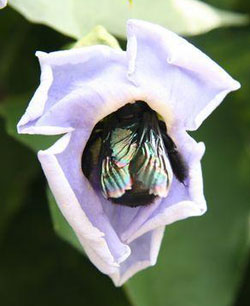Bees and flowers disappearing together
Bees and flowers disappearing together
University of Leeds
July 23, 2006
The diversity of bees and of the flowers they pollinate, has declined significantly in Britain and the Netherlands over the last 25 years according to research led by the University of Leeds and published in Science this Friday (21 July 2006). The paper is the first evidence of a widespread decline in bee diversity.
Concerns have been raised for years about the loss of pollination services, but until recently most of the evidence has been restricted to a few key species or a few focal sites. To test for more general declines, an international team of researchers from three UK universities (Leeds, Reading and York) and from the Netherlands and Germany compiled biodiversity records for 100s of sites, and found that bee diversity fell in almost 80% of them. Many bee species are declining or have become extinct in the UK [for detailed examples, see the attached case studies].
Lead author, Dr Koos Biesmeijer from the University of Leeds said: “We were shocked by decline in plants as well as bees. If this pattern is replicated elsewhere, the pollinator services’ we take for granted could be at risk. And with it the future for the plants we enjoy in our countryside.”
 Honeybee feeding on a morning glory flower EXAMPLES OF DECLINING BEES AND PLANTS RELATED LINKS |
Pollinators are essential for the reproduction of many wild flowers and crops. Co-author Simon Potts (of the University of Reading) said: “The economic value of pollination worldwide is thought to be between £20 and 50 billion each year.”
The team examined pollinator and plant data, collected by professional and volunteer researchers and naturalists in Britain and the Netherlands, comparing records from before and after 1980. The results showed bee diversity had declined consistently in both countries, whereas the diversity of hoverflies (another group of pollinating insects) stayed roughly constant in Britain, but increased in the Netherlands.
Loss of bee diversity in itself might not be too worrying, so long as other surviving insect pollinators are similar, and capable of pollinating the same flower species. However, this is not the case. The research found for both bees and hoverflies, the “winners” and “losers” were consistently different; insects which pollinate a limited range of flower species or which have specialised habitat needs were most often lost. Overall, a small number of common generalist pollinators are replacing a larger number of rarer specialist species.
Stuart Roberts from the University of Reading pointed out: “In Britain, pollinator species that were relatively rare in the past have tended to become rarer still, while the commoner species have become even more plentiful. Even in insects, the rich get richer and the poor get poorer.”
There have been parallel shifts in the plant world, with the plants that depend on pollination by bees disappearing too.
Dr Bill Kunin, coordinator of the project at the University of Leeds explained: “We looked at plant changes as an afterthought, and were surprised to see how strong the trends were. When we contacted our Dutch colleagues, we found out that they had begun spotting similar shifts in their wildflowers as well.”
In Britain, where bee diversity has fallen and hoverflies have at best held steady, there have been declines in 70% of the wildflowers that require insects for pollination. However, wind-pollinated or self-pollinating plants have held constant or increased.
The pattern is slightly different in the Netherlands, where bees have declined on average but hoverfly diversity has increased. In that country there has been a decline in plants that specifically require bees for pollination, but not in plants that can make use of other insect pollinators. Thus the plant declines closely mirror those of the pollinators.
This difference between the countries suggests the declines in pollinators and plants are causally linked. Researcher Dr Ralf Ohlemüller from the University of York explained: “The parallel declines of wildflowers and their pollinators seem too strong to be a coincidence.”
The research can’t tell us whether the bee declines are causing the plant declines, or vice versa, or indeed whether the two are locked in a vicious cycle in which each is affecting the other. It’s also not clear as of yet what the ultimate causes of the declines are, although land use change, agricultural chemicals and climate change may be important factors. The researchers hope to clarify these issues with follow-up studies.
Dr Biesmeijer said: “Whatever the cause, the study provides a worrying suggestion that declines in some species may trigger a cascade of local extinctions amongst other associated species.”
The research may not yet prove a global decline in pollination, but in two countries at least there is strong evidence that both wild pollinators and the wildflowers that they visit are in serious trouble.
This is a modified news release from the University of Leeds